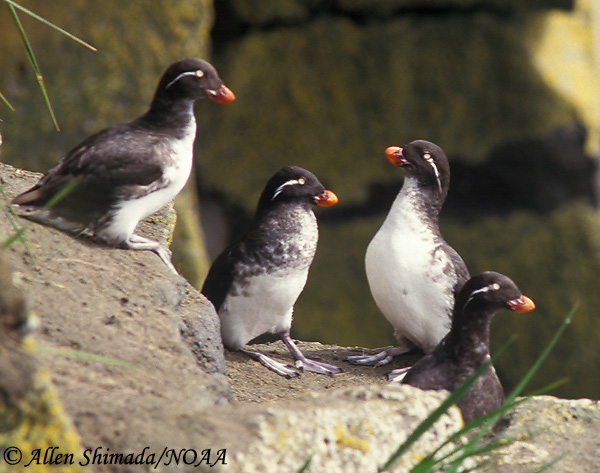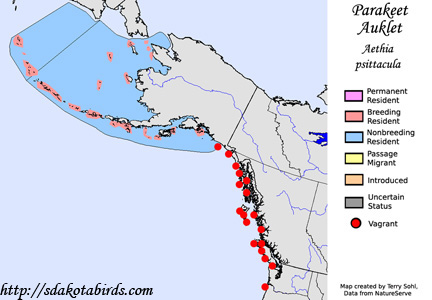| Length: 10 inches | Wingspan: 18 inches | Seasonality: Non-resident in South Dakota |
| ID Keys: Dark above, light below, white eyestripe, unusual upturned orange bill | ||
 The
Parakeet Auklet is a relatively small member of the auk family that lives in
the north Pacific. In the summer, mixed nesting colonies of Parakeet
Auklets and other Auklet species are found in the Aleutians, in many other
islands around the Bering Sea, and less often, in islands off the coast of
southern Alaska. They feed heavily on jellyfish, and their unusual,
round, upturned beak is likely an adaptation to help them capture and
consume their slippery prey.
The
Parakeet Auklet is a relatively small member of the auk family that lives in
the north Pacific. In the summer, mixed nesting colonies of Parakeet
Auklets and other Auklet species are found in the Aleutians, in many other
islands around the Bering Sea, and less often, in islands off the coast of
southern Alaska. They feed heavily on jellyfish, and their unusual,
round, upturned beak is likely an adaptation to help them capture and
consume their slippery prey.
Habitat: Found on islands with rocky cliffs or talus slides during the summer breeding season. At other seasons, often found far out to sea, and often found far from nesting colonies.
Diet: Feeds heavily on jellyfish, but also eats small crustaceans such as shrimp and amphipods, and small fish.
Behavior: Feeds by diving and swimming underwater.
Nesting: The nesting of a Parakeet Auklets occur in rocky areas mixed with soil and vegetation. There is no nest construction. Females lay a single egg directly on rock or soil in a deep rock crevice or depression. Both the males and females will incubate the egg, and both parents help to feed the youngster when it hatches.
Song: On breeding grounds, adult birds have a variety of harsh repetitive calls. They are mostly silent outside of the breeding season.
Migration: Breeds in a number of island breeding locations in and around the Bering Sea including the Aleutians, less on southern Alaska coastal islands. Disperses widely during the winter, with birds being found far out at sea, and as far south as California on occasion.
Interactive eBird Map: Click here to access an interactive eBird map of Parakeet Aukleet sightings
Similar Species: Whiskered Auklet, Crested Auklet
Conservation Status: Populations have been decimated on some nesting colonies where rats have been inroduced.. However, they are still widespread and common in parts of their range. The IUCN lists the Parakeet Auklet as a species of "Least Concern".
Further Information: 1) USGS Bird Infocenter - Parakeet Auklet
2) BirdWeb.org - Parakeet Auklet
3) Alaska Seabird Information Series - Parakeet Auklet
Photo Information: Photo taken by Allen Shimada - Decenber 20th, 2010 - Pribolof Islands, Alaska - NOAA Photo Library - Licensed under Creative Commons Attribution 2.0 Generic License.
| Click below for a higher-resolution map |
 |
| South Dakota Status: Non-resident in South Dakota |
Additional Parakeet Auklet Photos (coming soon!)
